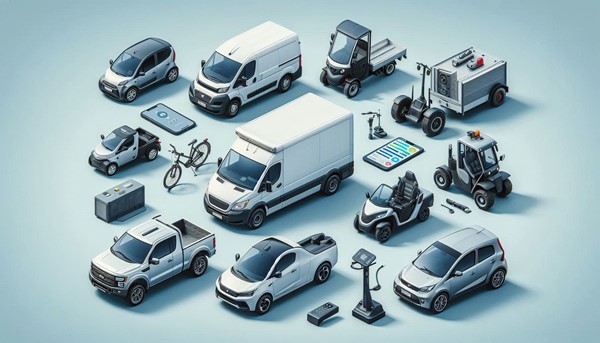Explore your fleet finance options in Australia. Compare chattel mortgages, EV loans, and leasing for tradies and couriers in 2025.
Key takeaways
If you're short on time, here's what you need to know:
- Fleet finance is growing fast: 67% of small Aussie trade businesses plan to expand or upgrade fleets in 2024 (ABS Business Conditions Survey).
- Chattel mortgages lead for asset ownership, with GST claims and depreciation perks.
- Operating and novated leases are gaining traction with couriers due to lower upfront costs and flexible terms.
- EV finance is rising, with concessional rates available via the Clean Energy Finance Corporation.
- Used vehicle loans suit smaller operators, offering quicker approvals and fewer conditions.
- Fleet size matters: Under 5 vehicles? Consider small business loans or hire purchase. 5+ vehicles, fleet leasing offers better value.
- EOFY tax perks, like the Instant Asset Write-Off (under 2025 review), could impact your finance choice.
Introduction: why fleet finance matters for tradies and couriers
Whether you're a plumber with two vans or a courier company running 15 vehicles across Sydney, having the right fleet finance strategy can directly affect your bottom line. Rising vehicle prices, insurance, and fuel costs mean that managing cash flow is more critical than ever.
The good news? In Australia’s 2025 lending environment, there are more tailored fleet finance solutions than ever for tradespeople and delivery operators. From low-doc loans to EV funding, the market is shifting toward flexibility, efficiency, and smarter asset management.
Understanding your fleet finance options
1. Chattel mortgage (most popular for ownership-focused buyers)
A chattel mortgage is a type of secured loan where your business owns the vehicle from day one.
Best for: Tradies and fleet operators wanting to own their vehicles and claim tax deductions.
Key features:
- Full ownership from the start
- Interest and depreciation may be tax-deductible
- GST on the purchase price may be claimed upfront (if registered for GST)
- Flexible loan terms (1–7 years)
- Balloon payment options available
2. Commercial hire purchase (CHP)
This is where the lender owns the vehicle during the loan term, and you take ownership once it’s fully paid off.
Best for: Businesses wanting to manage cash flow with predictable payments and ownership at the end.
Pros:
- Lower upfront cost compared to buying outright
- Structured repayments for easier budgeting
- Tax-deductible interest and depreciation
Cons:
- Less flexibility than leases
- Not ideal for businesses wanting to upgrade frequently
3. Finance lease (leasing for access, not ownership)
With a finance lease, the lender buys the vehicle and leases it to you for a set term. You may have the option to buy it at the end.
Best for: Couriers and logistics operators needing flexibility, or those operating short-term contracts.
Why it's trending:
- Lower upfront costs
- Often includes maintenance
- Off-balance-sheet financing (depending on structure)
4. Operating lease (true lease)
Similar to a rental – you return the vehicle at the end of the lease term without ownership obligations.
Best for: Courier fleets and tradespeople who need new vehicles every few years or want hassle-free upgrades.
Benefits:
- Includes registration, servicing, and insurance
- Easier budgeting with fixed monthly costs
- No resale hassle
5. Novated lease (ideal for employee fleets)
A novated lease is a three-way agreement between employer, employee, and finance company. Often used for salary packaging.
Best for: Businesses offering vehicles to employees as part of their benefits package.
Considerations:
- May provide tax advantages for employees
- Simplifies vehicle provision without business ownership
- EV novated leases are tax-free under ATO exemptions until at least 2025
EV and hybrid vehicle finance options
Australia’s EV market is expanding fast. In fact, 15.6% of all new vehicle sales in 2024 were electric (EV Council Report).
If you're considering switching to electric vans or utes:
- The Clean Energy Finance Corporation (CEFC) offers concessional finance for eligible EVs
- Some lenders offer green loans with lower interest rates for hybrid or electric models
- The government Fringe Benefits Tax (FBT) exemption still applies for EVs under $89,332
Used vehicle finance: a viable path for smaller operators
If you're running a smaller trade business or just starting out, used vehicle finance might be a smarter choice.
Why consider it?
- Lower capital outlay
- Easier approval (some lenders offer no-doc or low-doc loans)
- Shorter loan terms available
- More flexible eligibility criteria
EOFY and instant asset write-off incentives
With the ATO’s instant asset write-off threshold expected to remain at $20,000 per asset for eligible small businesses (pending further updates in 2025), timing your fleet purchase around EOFY could reduce your taxable income.
EOFY strategies:
- Time chattel mortgage purchases to claim full GST and depreciation
- Bundle multiple vehicles under finance before 30 June to access higher deductions
- Review your tax planning strategy with a finance broker or accountant
Fleet finance based on fleet size
Your ideal fleet finance option often depends on how many vehicles you're looking to finance. Here's a breakdown by fleet size:
- 1–2 vehicles:
- Chattel mortgage (for full ownership and tax benefits)
- Used vehicle loan (ideal for budget-conscious businesses)
- Commercial hire purchase (for predictable payments and ownership at the end)
- 3–5 vehicles:
- Structured loan bundles (multiple vehicles under a single loan structure)
- Finance lease (access without full ownership)
- Novated lease (especially if you're providing vehicles to staff)
- 6 or more vehicles:
- Fleet operating lease (streamlined management with inclusions like servicing and registration)
- Master lease agreements (flexible arrangements as your fleet grows)
- EV leasing (tap into electric fleet incentives and concessional rates)
As your fleet expands, it often makes sense to explore fleet management packages—these can include everything from servicing and maintenance to fuel cards and GPS tracking.
Common eligibility and documentation requirements
Here’s what lenders typically look for:
- Valid ABN (2+ years preferred, but some accept new ABNs)
- Business bank statements (3–6 months)
- Driver's licence and vehicle details
- Proof of income or low-doc alternatives for smaller loans
- GST registration (required for most chattel mortgages)
FAQ: your fleet finance questions answered
1. Can I finance more than one vehicle at a time?
Yes, most lenders offer bundled fleet finance for 2 or more vehicles. You can negotiate better rates with larger volumes.
2. Do I need a deposit?
Not always. Some chattel mortgage and leasing options offer 100% financing if your credit and business history are strong.
3. Is fleet finance available for sole traders?
Absolutely. Low-doc and used vehicle loans are common for sole traders. Make sure your ABN and income documentation are ready.
4. Can I get fleet finance for electric vehicles?
Yes. Several lenders now offer EV-specific loans with incentives, lower rates, or longer terms.
5. How long does approval take?
Some lenders offer 24–48 hour approvals, especially for used or low-doc loans. Complex fleets may take 5–7 business days.
Conclusion: Drive your business forward with the right finance
Whether you're scaling your plumbing business or upgrading your courier fleet, choosing the right fleet finance can help you grow without straining your cash flow. With rising fuel prices, evolving tax incentives, and EV adoption gaining momentum in Australia, there’s never been a better time to explore your financing options.
Take the time to assess your fleet size, cash flow, and long-term plans — and don’t hesitate to speak to a broker who understands the nuances of the trade and logistics industry.


